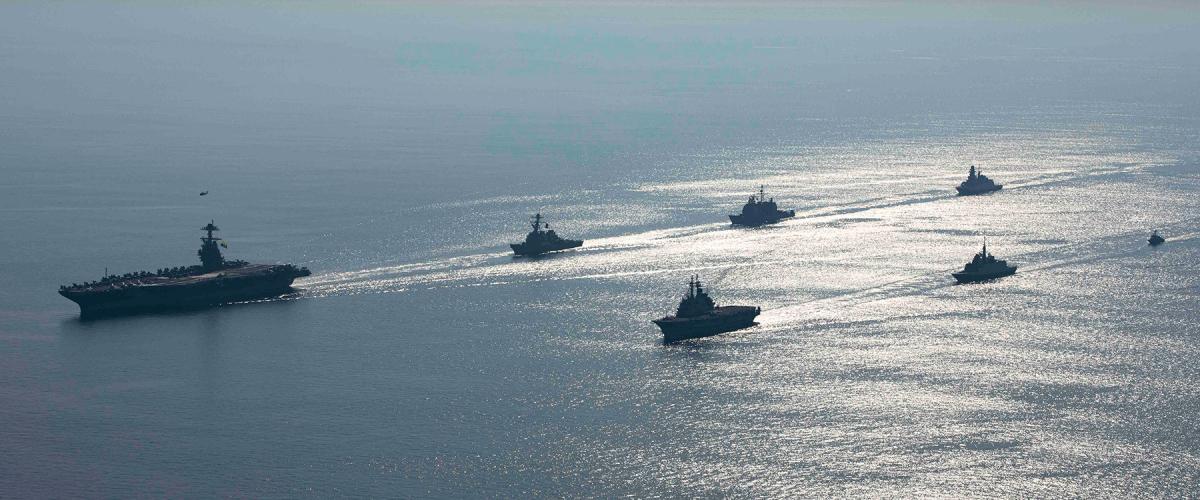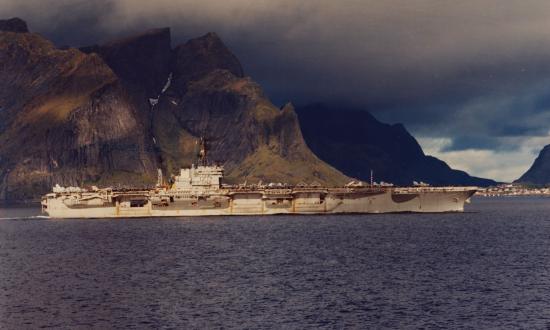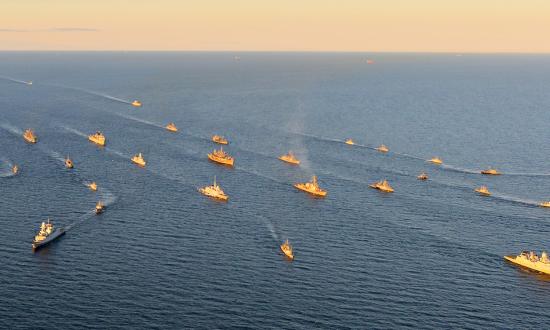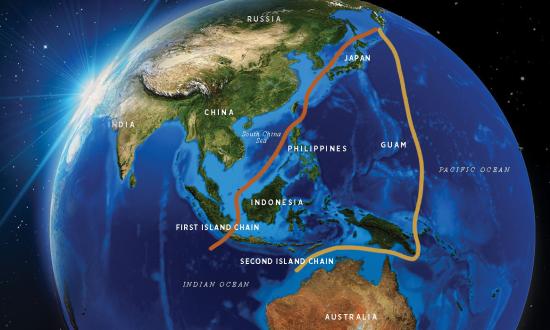The 1970s were a tough decade for the U.S. Navy. The U.S. withdrawal from Vietnam brought budget cuts, exacerbated by the perception of strategic parity and détente with the Soviet Union. The fleet was rusting away as funds for recapitalization were spent in the jungles of Southeast Asia. The 1979 Soviet invasion of Afghanistan and the fall of the Shah of Iran elevated the possibility of regional and global conflict. More relevant to the Navy was work done by naval intelligence to determine the real aims of Soviet naval strategy.1 The growing numbers of Soviet nuclear-powered attack submarines (SSNs), missile-armed warships, bombers, and patrol aircraft gave the appearance of a navy planning for blue-water operations and interdiction of U.S. convoys in the Atlantic.2 However, the advent of long-range submarine-launched ballistic missiles enabled Soviet nuclear-powered ballistic-missile submarines (SSBNs) to operate in “bastions” closer to home.3 This transferred the initiative for offensive maritime operations into the hands of the United States.4 The 1986 Maritime Strategy and effort to achieve a 600-ship fleet were the U.S. Navy’s response. Although this history is well documented, an underappreciated theme emerged: Maritime strategy must be a living document that offers considerable value for Congress, strategists, war planners, program managers, budgeteers, and even the American public.5
The Enduring Value of the Maritime Strategy
Norman Friedman best describes the need for a distinctly naval strategy:
Why, then, should the Navy need an explicit strategy? The answer has to be that the choice of a strategy focuses interest and creative energy within the Navy on the solution of the tactical and technical problems associated with that strategy: on how to fight. Failing such a selection of a particular strategy or a class of strategies, the Navy expends much of its energy in more abstract debate. Without some basic choice it is impossible for the Navy to place relative values on its various [programs]; evaluation is necessary if, given limited funds, intelligent choices are to be made. Elaboration of the strategy can, moreover, reveal significant gaps in naval strength which might otherwise be considered unimportant. Only third would one add that, by adopting a particular strategy, the Navy can explain itself most effectively to the public which assigns its resources.6
The 1986 Maritime Strategy was crafted out of an internal intellectual and organizational process: It was a warfighting document, a statement on acquisition programs, and a public relations effort. There is merit in considering these components individually.
The Maritime Strategy as an Internal Affair
It is easy for parochial interests and bureaucratic processes to hamper the Navy’s effectiveness and distract its members. An effective strategy serves as a critical organizing principle. Chief of Naval Operations (CNO) Admiral James D. Watkins believed the Maritime Strategy was his top priority, stating, “Once we all felt good about it . . . the organization flowed from that. Because the people in the organization see themselves very clearly in the strategy.”7 In addition, it is important that the strategy was a product of an internal process. Vice Admiral Stansfield Turner, president of the Naval War College (NWC) during the early 1970s, lamented the Navy’s “increasing reliance on civilians and on ‘think tanks’ to do our thinking for us. . . . We must be able to produce military men who are a match for the best of the civilian strategists or we will abdicate control of our profession.”8
Strategists and analysts from the Office of the CNO (OPNAV), NWC, and the CNO’s Strategic Studies Group (SSG) were important in the development and implementation of the Maritime Strategy. Maintaining a cadre of dedicated strategists within the Navy, many of them in uniform, was a key element in achieving greater buy-in from the fleet and opening a channel for fleet assets to test and learn from the strategy. As an internally developed product with the support of senior Navy leaders, the Maritime Strategy was positioned to be a more actionable and amendable document than anything created by a joint or civilian entity.9 CNO Admiral Thomas B. Hayward rightly stated in 1981 that “there is no dearth of strategic thinking going on these days in your navy. What is lacking is a more useful way to capitalize upon that abundant talent with more alacrity.”10 The same is true today, with growing recognition of the need to invest in naval strategy; to produce more officers who can think strategically; to have better education for them; and for senior civilian and military leaders to pay more attention to strategy.
The Maritime Strategy as a Warfighting Document
A strategy also provides a theory of victory for military forces on several levels. An important tenet of the 1986 Maritime Strategy was to keep war conventional by giving senior leaders the option to attack the Soviet Union’s flanks, divert its resources and attention across its vast empire in a prolonged conflict, and terminate hostilities on favorable terms. Operationally speaking, this meant having U.S. and allied naval forces sweep the Soviet Navy from the seas, threaten Soviet flanks with amphibious forces, and project power ashore with carrier airpower and land-attack cruise missiles. Tactical and technical innovations were reflected in the Outer Air Battle, Aegis, and a renewed emphasis on antisubmarine warfare. An anecdote that best reflected these efforts was a conversation between Second Fleet commander Vice Admiral Hank Mustin and European reporters in London, the latter of whom asked, “Won’t your actions stir the Soviets to bolster their defenses?” to which Mustin replied, “Yeah, and they’ll need all they can get!”
Independent of Cold War competition, the Maritime Strategy was a useful hedge against any contingency, be it a great power conflict, regional war, littoral operations, or peacetime deterrence. CNO Watkins clearly stated this in 1984 budget hearings:
We want to affect enemy strategy and will: in peace to ensure stability and protect our interests without recourse to force; in crisis to contain or to resolve the dispute on our terms before crisis escalates to conflict; and in war to terminate conflict on our terms at the lowest possible level of damage and loss. These concepts are central to maritime strategy.11
He further claimed in his public unveiling of the Maritime Strategy that “sea power is relevant across the spectrum of conflict.”12 These uses of naval strategy have not diminished in relevance with the passage of time. The details of warfighting undoubtedly change; evolving tactics, technologies, and combatants demand a strategy not remain static. In an institution as vast as the naval service, every member, military and civilian, must be able to point to the role they play in the bigger picture. Aside from those elements that must remain classified, there is value in being explicit when it comes to strategy. The Maritime Strategy specifically mentioned targeting Soviet SSBNs through “strategic antisubmarine warfare,” an arguably dangerous and escalatory policy that stimulated much debate regarding its efficacy.13 This example demonstrates the openness with which warfighting was discussed in the Maritime Strategy. A publicized strategy today would be well served by similar honesty.
The Maritime Strategy as a Force Structure Plan
The 600-ship Navy was a requirements-driven target that included a broad array of ship types. Secretary of the Navy John Lehman openly communicated the need for a fleet of this size, showed how the demand for ships across the various fleets added up to 600, and made an effort to placate critics by detailing the cost-saving measures in place to make the plan affordable. In addition, the plan stated its assumptions regarding lengths of deployments, maintenance considerations, and requirements in both peacetime and wartime, as well as what ships counted toward the goal of 600. Today, force structure proposals vary by who produces them—whether from the Navy, the Pentagon, think tanks, or presidential administrations—and by what is counted and whether it is limited to “battle force ships” or a more expansive definition that includes auxiliaries and unmanned vessels.
The fleet reached a post-Vietnam low of 521 ships in 1981, with most—but not all—of the ones built during the 1940s and 1950s retired to fund modernization.14 The effort to grow the fleet was comprehensive in scope and efficient in resource allocation. Two-ship contracts for construction of Nimitz-class carriers in fiscal years (FYs) 1983 and 1988 achieved some economies of scale, often difficult given the few CVNs under construction at any given time.15 The Ticonderoga-class guided-missile cruisers integrated the revolutionary Aegis Combat System and, after the first five, a vertical launching system that increased the number and variety of missiles carried on board.16 However, these high-end cruisers were based on the existing Spruance-class destroyer hull and built in sufficient quantities to yield savings compared with nuclear-powered cruisers of the past.17 Furthermore, SSBN and SSN construction was greatly accelerated with the new Ohio and Los Angeles classes entering the fleet. Low-end ships—such as guided-missile frigates of the Oliver Hazard Perry class, mine-countermeasures ships, and fleet auxiliaries—were also procured in greater numbers.
Much of the budgetary windfall the Navy received did not even go to shipbuilding. From FY1984 to FY1986, appropriations for military pay, operations and maintenance, and research, development, test, and evaluation increased significantly, with no gains in the shipbuilding and conversion account.18 The fleet’s capability was improved beyond ship counts by gains in material readiness and personnel retention rates.19 Unfortunately, there are no silver bullets for force structure and ship construction. A broad array of ships must be built to prevent the atrophy of a given part of the fleet, enabling it to prevail across the spectrum of conflict, and in numbers great enough to reduce their individual cost. These hard choices can best be made under the umbrella of a coherent strategy.
The Maritime Strategy as Public Relations
The Maritime Strategy was the product of an increasingly public deliberative process.20 A naval strategy is a statement of desired ends, ways, and means that relies on fiscal, policy, and conceptual support from the White House, Congress, and the American people. In this case, the Maritime Strategy was the Navy’s attempt to demonstrate its enhanced value as an instrument of national security in a time of increased interservice rivalry.
History is full of examples of toxic interservice rivalries, in times of war and peace, over strategies and programs. However, a healthy interservice rivalry can be useful. Rear Admiral J. C. Wylie described this best:
We do differ, within and among the services, and may Heaven help us if we ever enter into a period of prevailing sweetness and light and unanimity. Nothing would be more dangerous to our nation than the comfortable and placid acceptance of a single idea, a single and exclusively dominant military pattern of thought. The political parallel is almost too obvious to mention.
Given the unrelenting march toward a more joint military, it is worth remembering that the services should compete with one another and advocate for their respective interests. In this vein, criticisms of the Maritime Strategy regarding its aims, use of resources, and risks of escalation are irrelevant.21 After being briefed on the Maritime Strategy in November of 1982, Secretary Lehman remarked, “Bravo, you have just given us a handbook that can be used in our deliberations with the third deck [Office of the Secretary of Defense], with Congress, with OMB, and the joint arena.”22
Overall, given the increased budget and operational latitude given to the Navy during the 1980s, one must conclude that the Maritime Strategy was successful as a public relations effort. There is no reason a strategy could not encourage such an outcome again.
A Living Document
Naval strategists should see the Maritime Strategy as a living document. A strict interpretation of the strategy as a purely anti-Soviet manifesto led to its premature dismissal when the Soviet Union disintegrated.23 It should have remained a “living strategy” that could adapt to the ever-evolving technologies, tactics, and global balance of power. Those who wrote the Maritime Strategy explicitly stated that this was its purpose.24
This is not a call to blindly copy the 1986 Maritime Strategy, exchange a few outdated words, and proclaim victory. However, it would be beneficial to mirror the process and effects of that strategy in guiding the Navy through its contemporary struggles. A strategy need not be an unalterable declaration of intentions. It should speak generally in its unabashed espousal of the Sea Services’ primacy and specifically in its applicability to pressing security threats. Perhaps most important, a strategy must come from within the Navy and with the support of senior uniformed and civilian officials.
1. Christopher Ford and David Rosenberg, The Admirals’ Advantage: U.S. Navy Operational Intelligence in World War II and the Cold War (Annapolis, MD: Naval Institute Press, 2005), 73.
2. Ford and Rosenberg, The Admirals’ Advantage, 55, 78.
3. Ford and Rosenberg, 79–84.
4. Ford and Rosenberg, 82, 87–88, 94–95.
5. Frederick H. Hartmann, Naval Renaissance: The U.S. Navy in the 1980s (Annapolis, MD: Naval Institute Press, 1990).
6. Norman Friedman, The U.S. Maritime Strategy (New York: Jane’s Publishing, 1988), 17.
7. Hartmann, Naval Renaissance, 70.
8. Hattendorf, The Evolution of the U.S. Navy’s Maritime Strategy, 1977-1986 (Newport, RI: U.S. Naval War College Press, 2004), 7.
9. For the unclassified strategy that was released to the public and was representative of multiple iterations over the course of several years, see: James D. Watkins, “The Maritime Strategy,”; It is dangerous to assume that fellow servicemembers across the joint force have the slightest understanding of the role naval power plays in times of war and peace. See: Haynes, Toward a New Maritime Strategy, 39.
10. Hattendorf, The Evolution of the U.S. Navy’s Maritime Strategy, 45.
11. Hartmann, Naval Renaissance, 153.
12. ADM James D. Watkins, USN, “The Maritime Strategy,” U.S. Naval Institute Proceedings 112, no. 1 (January 1986).
13. Watkins, “Maritime Strategy.”
14. Compared to 933 ships in the fleet at the height of the Vietnam War in 1968, see: Naval History and Heritage Command, “U.S. Navy Active Ship Force Levels, 1979–1985.”
15. Ryan A. Peeks, Aircraft Carrier Requirements and Strategy: 1977–2001 (Washington, DC: Naval History and Heritage Command, 2020), 57, 70.
16. Steven T. Wills, Strategy Shelved: The Collapse of Cold War Naval Strategic Planning (Annapolis, MD: Naval Institute Press), 74.
17. Hartmann, Naval Renaissance, 21; Wills, Strategy Shelved, 74.
18. Hartmann, Naval Renaissance, 159.
19. For a more complete discussion of rising rates of readiness and retention, see chapter 8 in Hartmann, Naval Renaissance.
20. The Maritime Strategy initially was published in the January 1986 issue of Proceedings. Peter Swartz has since written five editions of an annotated bibliography on “The Maritime Strategy Debates” that encompass everything written on the subject. This demonstrates that the Maritime Strategy was not written and decided on by a cabal of a select few, but rather was the result of an ongoing, iterative process with commentary from virtually all relevant stakeholders. The most recent annotated bibliography can be found in appendix II in Hattendorf, The Evolution of the U.S. Navy’s Maritime Strategy.
21. Peter M. Swartz, appendix II, in Hattendorf, The Evolution of the U.S. Navy’s Maritime Strategy.
22. Hattendorf, The Evolution of the U.S. Navy’s Maritime Strategy, 73.
23. Wills, Strategy Shelved, 100, 103–4.
24. Peter D. Haynes, Toward a New Maritime Strategy: American Naval Thinking in the Post-Cold War Era (Annapolis, MD: Naval Institute Press, 2015), 43.






